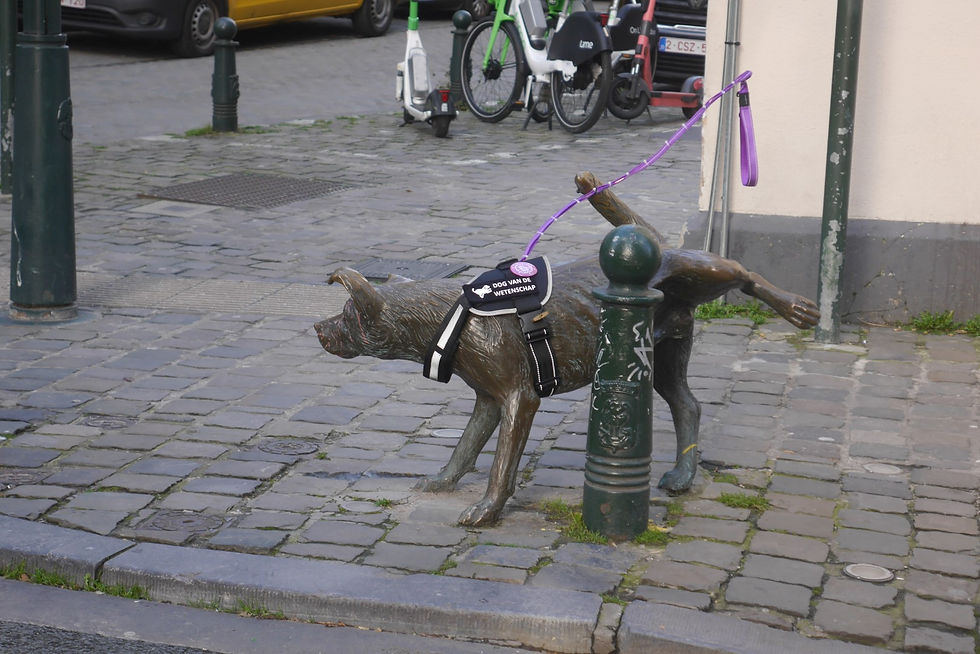- Shawn Basey

- Nov 25, 2024
- 6 min read

Most cities have that one big tourist attraction where you get there and you feel a little underwhelmed. In this, Brussels completely outdoes all the competition. The Mannekin Pis is just about the most underwhelming tourist sight you can ever imagine. Of course, no visit to Brussels is worth its piss if you don’t visit the famed pissing boy, but you also must lump that visit in with the pissing girl and the pissing dog. And after that, piss on a church (quite legally)! And then sit back and wonder if there’s more to Brussels than pissing.
I’ve already written quite a lot on this blog about Belgian pissing culture. Though I never shared this anecdote: I had a Belgian friend who was driving through the Netherlands and he really had to piss. So he did what was natural. Pulled over to the side of the highway, found a bush, and let it fly. The police immediately arrived.
“What are you doing?!” the Dutch officer asked.
“What does it look like?” my friend replied, cigarette hanging from his mouth, penis hanging from his hand.
“You are a savage,” the Dutchman said.
“I am a Belgian,” my friend replied.
“Do you not have toilets in Belgium?”
My friend shrugged. Indeed, toilets are often hard to come by in this country. And when you do come by them, they’re often… weird. Again, see my other blog on this.
Anyways, back to Mannekin Pis. Why is that little guy so revered? Let’s delve in.
A short history of Pis
By the way, I’m not overly sure how to pronounce “Pis”. Is it like the French would say, “Pee”? Though my kid came home from French school, and he pronounced it with the “s”, so perhaps it’s true to the Flemish form.
Regardless as to how it's pronounced, the Manneken Pis is more of a symbol of Brussels than just a transparent metaphor for late-night happenings.
The fountain first made its appearance in 1619 when Hieronimus Duquesnoy the Elder completed it. The meaning and purpose behind it has been lost in the mists of the early morning steam of a… sorry, I can’t help myself to the urination metaphors.
Duquesnoy was born in Le Quesnoy and died in Brussels, and was the court sculptor for Archduke Albert and Archduchess Isabella. Most of his life was spent working on church furniture and sculptures for the royal palace and gardens. Along with this piece, you can find a sacrament tower in Sint-Martinuskerk in Aalst and another one in Sint-Jakobskerk in Ghent.
Origin stories
The first story I heard was that when Brussels was under siege by the French, Dutch, German, or some other army, a fire was ignited in the city. A young, heroic boy sped to the task of putting out the fire—or fuse from explosives, or something—the only way he could think of: by pissing on it! I told that one to my 5-year-old; he loved it. Though this probably explains all of his joking lately with his toilet.
Another story, which I just learned from AI—so take it or leave it—is that a wealthy merchant’s son peed on a witch’s door, so she turned him into a statue. Now that I’ve read that, I kind of would like to believe that one’s true, but then, this being Brussels, there’d be a lot more pissing statues about…
The dressing begins
Though we can’t date the statue, we do know when the whole dressing thing started. It started in 1746, after the French took Brussels (then at the time part of the Netherlands) during the War of Austrian Succession and occupied the city. The French, seeing how the Brusselaar had a weird reverence for the pissing boy, often mocked it as they passed. The Brusselaar complained up the chain of command that their boy was being mistreated.
Seeing that French attitudes could cause an uprising there, the French King Louis XV, gifted the statue a royal gown, and he made the order that every French soldier passing the statue would have to salute.

Since then, they’ve taken up dressing the boy in all kinds of clothes.
All the Pissing Clothes
Over the course of his lifetime, our favorite little Belgien has had over 1,000 outfits. He changes outfits for any occasion, pending a request and donation to the city. That’s right, that means you too can design your own little pissing boy clothes and have him wear it (for the right price). They change him up to three times a day, and being a pissing boy dresser is an official, full-time job of the city.

I’ve seen him wearing a Georgian chokha for Georgian Independence Day, some Italian national clothes, firefighting clothes, graduation clothes, and so on. Really, I don’t remember all the different clothes I’ve seen on him. Most embassies, though, will sponsor an outfit during the Independence Day of their country, and the Church (or some rich religious guy) often has him dress up for religious days.
Lucky for you, they even have many of his clothes on display. Right around the corner, there’s the Garderobe MannekenPis just a spitting distance away. So, if you want the complete experience, you can see the fountain, grab a penis waffle at one of the adult waffle vendors, and scarf that down, and then go to the museum.
On the side of the museum, there’s a gigantic mural of “Manneken Peace”, so don’t miss that. The museum is 5 euro to get in and includes a fairly amusing audio tour (it’s also included in the Belgium Museum Pass).

The Pissing Ceremony
Whenever they change the clothes, the sponsor of the getup comes out and makes a little speech to their cohort. Then the caretakers change the clothes, and they do some photo ops. At almost every ceremony I’ve seen, one of the caretakers has a lot of fun controlling the flow in the fountain. That means, at any moment, a “golden stream” shoots out across the street like a broken fire hydrant.
And a Pissing Girl…
Manneken isn’t the only pisser in town. There are, in fact, two more pissing statues, as the Belgians are very much aware of how ridiculous their main tourist icon is.
There’s Jeanekke Pis, who squats down in the “Delirium Village” (itself a tourist icon), don’t go at night or you’ll run into an immovable wall of tourists blocking your way to peep at a statue of a baby girl pissing.

Just head down the Delirium cul-de-sac (fun fact, though you can use that word the same in French, it also means “ass bag”) and you’ll find her at the end, surrounded by a swarm of curious Asians and Russians inspired by Western degeneracy all trying to snap a pic.
She’s been there since 1987. The artist Denis-Adrien Debouvre wanted to express his solidarity with women’s rights and show that Brussels is a truly egalitarian city. It’s tradition to throw money into the fountain, and that money is collected and donated to medical research and people in need.
At night, they lock her up with the cage doors to avoid getting damaged or humiliated by all the drunks gathering at Delirium. But on occasion during the day, you can find her fully exposed.
And even a Pissing Dog
Meanwhile, a bit on the opposite end of Old Town, we’ve got Zinneke Pis (also the name of a beer), a famous pissing dog that’s marking his turf on a bollard. The last few times I’ve seen it, the water hasn’t been running though, so don’t expect too be overwhelmed by the action.

Zinneke has been there since 1999 and was installed by Tom Frantzen as a nod to Jeanneke, and was so popular that they made a copy of him in Neufchatel-Hardelot, France. The poor guy met the fate of many street dogs and was ran over by a car, but lucky for Zinneke, Tom was around to freshen him back up. His name is a nod to the River Senne, which runs at a trickle underneath the city.
Final thoughts
So, take a moment to appreciate the playful spirit of this city. Whether you're marveling at the ever-changing wardrobe of the Manneken Pis, having a laugh at the pissing dog, or tourist dodging at the crowded Delirium Village, remember that Brussels is a city that doesn't take itself too seriously. And maybe, just maybe, you'll find yourself charmed by its irreverent wit and silliness. Just don’t mind the smell.































